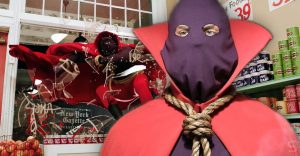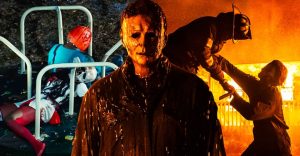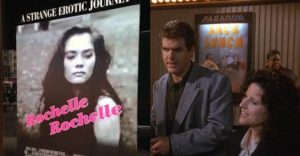10 Quirky Behind-The-Scenes Facts About The Grand Budapest Hotel

All of Wes Anderson’s movies have been well-received by critics, but one that received particular attention from critics, moviegoers, and even Academy voters is The Grand Budapest Hotel, his sprawling tale of a hotel through the ages. With its unconventional narrative structure, perfectly symmetrical cinematic composition, and performances that walk the line between hilarious and poignant, a movie like The Grand Budapest Hotel doesn’t just happen overnight.
It’s the result of diligent work behind the scenes by a talented cast and crew dedicated to bringing a director’s vision to life.
10 Harvey Keitel slapped Tony Revolori in the face 42 times

There’s a scene in The Grand Budapest Hotel in which Ludwig, played by Harvey Keitel, says, “Good luck, kid!” before slapping Tony Revolori’s character Zero across the face. There were no stunt doubles or Hollywood fakery involved in this scene; Keitel really slapped Revolori.
Wes Anderson shot 42 takes of this scene before getting one that he was happy with, and Keitel actually slapped Revolori in the face every single time.
9 Angela Lansbury was originally cast to play Madame D.

The original choice for the role of Madame D. was Angela Lansbury, and she even accepted the part. However, she had to drop out before filming, because the movie’s shoot was going to coincide with her commitments to a stage production of Driving Miss Daisy. Elsewhere in the casting process, Vincent Cassel and Jean Dujardin were both up for the part of Serge X, which eventually went to Mathieu Amalric.
When the movie was in pre-production, it was reported that Johnny Depp was being considered for the lead role of M. Gustave, but Wes Anderson has denied this and said that it was just a rumor.
8 On-screen newspaper headlines secretly spoil the movie

All throughout The Grand Budapest Hotel, whenever a character is reading a newspaper and the headlines are visible on-screen, they adhere to the events of the film. In most movies, when a newspaper headline is shown, the content of the articles will have nothing to do with the plot of the film. But Wes Anderson personally wrote every newspaper headline featured in The Grand Budapest Hotel.
There’s even a newspaper article that can be spotted on-screen near the beginning of the movie that secretly spoils the whole plot, including the ending.
7 Saoirse Ronan had a hard time making the courtesan au chocolat

Saoirse Ronan’s character in The Grand Budapest Hotel, Agatha, is a master of baking courtesan au chocolat. Most movies would just get a real baker to come and bake the food, then bring in the actor to open the oven and pretend they made it, because that’s what acting is: pretending.
But since the courtesan au chocolat was so essential to the story, and to the character of Agatha, Wes Anderson insisted on Ronan learning how to make it herself, and actually baking it on-screen. Ronan didn’t find pastry-making easy to master.
6 The cast and crew all stayed in the same hotel

While filming The Grand Budapest Hotel, the cast and crew all stayed at the same hotel: the Hotel Börse in Görlitz, Germany, where a lot of the movie was filmed. Wes Anderson insisted that all of the wardrobe fittings and makeup application be done in the hotel lobby, too.
These were just measures to expedite production, because they only had between seven and eight hours of natural light throughout the day. The owner of the Hotel Börse appears in the final film as an extra, working on the Grand Budapest Hotel’s front desk.
5 It took five hours to apply Tilda Swinton’s old lady makeup

Tilda Swinton played an 84-year-old socialite named Madame D. in The Grand Budapest Hotel. This required Swinton to spend five hours in the makeup chair before each day of filming.
Wes Anderson said that, while his movies are usually shot for modest budgets and he doesn’t have a ton of money to splash out on extravagant services, he decided to get the makeup artists that could command the highest fee when it came to Swinton’s Madame D. prosthetics, because he wanted it to be convincing. And in the final movie, it is pretty convincing.
4 The Grand Budapest Hotel was shot in three different aspect ratios

Wes Anderson decided to shoot The Grand Budapest Hotel in three different aspect ratios – 1.37:1, 1.85:1, and 2.35:1 – in order to help the audience to differentiate between the three historical periods in which the film is set (the 1980s, the 1960s, and the 1930s).
Despite this, the producers gave very strict instructions to theater projectionists about how to project the movie. They were instructed to project the movie in 1.85:1, which is the standard setting. Projectionists were also given notes on technicalities like image brightness and audio configuration.
3 A behind-the-scenes anecdote got Ralph Fiennes incorrectly labeled a diva

Graphic designer Annie Atkins, who worked on this movie, talked about the film’s careful attention to detail in interviews. She started using an example in which she created a prop notebook for M. Gustave to carry around. Ralph Fiennes saw that the notebook didn’t have lined paper, and suggested that due to the character’s meticulously organized nature, he wouldn’t write on non-lined paper. Atkins caught this and rectified it.
However, when she told the story, she was misinterpreted, and instead of being a story about the detail in the movie, it was reported as a story about Fiennes being a difficult-to-work-with diva.
2 Zero was the toughest role to cast

Casting director Douglas Aibel managed to get a ton of famous faces for the major roles in The Grand Budapest Hotel, but the role that proved the toughest to cast was Zero. Aibel was looking for “a relatively unknown teenage boy, preferably of Arabic origin, to carry the role.”
Tony Revolori eventually won the role when he sent in an audition tape that wowed producers. Revolori has since gone on to play Flash Thompson – the kid who bullies Peter Parker and reveres Spider-Man without realizing they’re the same person – in the Marvel Cinematic Universe.
1 Stefan Zweig inspired the whole thing

According to Wes Anderson, the biggest influence on The Grand Budapest Hotel (at least from a storytelling perspective) was the work of writer Stefan Zweig: “I just, more or less by chance, bought a copy of Beware of Pity. I loved this first book, and immediately there were dozens more in front of me…They were all suddenly back in print. I also read The Post Office Girl…The Grand Budapest Hotel has elements that were sort of stolen from both these books.”
The author character, played by Jude Law as a young man and Tom Wilkinson as an old man, was heavily inspired by Zweig’s own personality.
About The Author


















